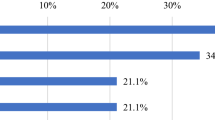Abstract
This study examined the possibility that notonly women, but also men, face what Hall and Sandler(1982) call “chilling” behaviors when theyare students in a major considered nontraditional oratypical for their sex. The population for this studywas all upper-level students (N = 1,992) in accounting,education, engineering, and nursing at a publicuniversity in the mid-South. A random sample of females and males, or a total of 426 junior and seniorfull-time and part-time students in these majors, wasmailed a survey about chilling practices in their major.Analysis of variance was used to clarify the relationships between the independent variablesof students' sex and academic discipline and theinteraction of students' sex and academic discipline andthe dependent variable of perception of practices in their major. The findings indicated that,regardless of their sex, students in these majors didnot perceive practices in their major to be“chilling.” However, there was a differencein perceptions as a function of major. Both education andnursing students perceived a “warmer”environment in their major than did accounting andengineering students. The pattern was the same for bothfemales and males since there was no interaction of sex andacademic discipline.
Similar content being viewed by others
REFERENCES
Banks, T. L. (1988). Gender bias in the classroom. Journal of Legal Education38: 137± 146.
Barrett, M. C. (1996, November). Students' perceptions of their undergraduate science and engineering classroom experiences. Paper presented at the meeting of the Association for the Study of Higher Education, Memphis, TN.
Blankenship, L. L. (1985). Examining gender differences: The campus environment survey. Unpublished master' s thesis, University of Maryland, College Park.
Constantinople, A., Cornelius, R., and Gray, J. (1988). The chilly climate: Fact or artifact. Journal of Higher Education59: 527±550.
Cornelius, R. R., Gray, J. M., and Constantinople, A. P. (1990). Student-faculty interaction in the college classroom. Journal of Research and Development in Education23: 189±197.
Cranston, P. (1989). Sex differences in undergraduates' experiences of campus microinequities. Journal of College Student Development30: 313±318.
Cranston, P., and Leonard, M. M. (1990). The relationship between undergraduates' experiences of campus micro-inequities and their self-esteem and aspirations. Journal of College Student Development31(5): 395±401.
Crawford, M., and MacLeod, M. (1990). Gender in the college classroom: An assessment of the ª chilly climateº for women. Sex Roles23: 101±122.
Fischer, A. R., and Good, G. E. (1994). Gender, self, and others: Perceptions of the campus environment. Journal of Counseling Psychology41: 343±355.
Foster, T. J., Foster, M. S., Flaugh, K., Kinschner, J., Locke, E., and Pidcock, N. (1994). An empirical test of Hall and Sandler' s 1982 report: Who finds the classroom climate chilly? Paper presented at the Central State Communication Association Convention, Oklahoma City, April 1994. (ERIC Document Reproduction Service No. ED373 368).
Hall, R. M., and Sandler, B. R. (1982). The Classroom Climate: A Chilly One for Women?Association of American Colleges, Washington, DC. Project on the Status and Education of Women (ERIC Document Reproduction Service No. ED 215 628).
Heller, J. F., Puff, C. R., and Mills, C. J. (1985). Assessment of the chilly college climate for women. Journal of Higher Education56: 446±461.
Hurtado, S., Milem, J., Clayton-Pederson, A. R., and Allen, W. R. (1998). Enhancing campus climates for racial/ethnic diversity: Educational policy and practice. Review of Higher Education21 (3): 279±302.
Leonard, M. M., and Ossana, S. (1987). Technical manual for the Campus Environment Survey. Unpublished manual, University of Maryland Counseling Center.
National Center for Educational Statistics (1975). Digest of Educational Statistics. Washington: DC: U.S. Government Printing Office.
National Center for Educational Statistics (1995). Digest of Educational Statistics. Washington, DC: U.S. Government Printing Office.
Ossana, S. M. (1986). The relationship between women' s perception of the campus environment and self-esteem as moderated by women' s identity attitudes. Unpublished master' s thesis, University of Maryland, College Park.
Ossana, S. M., Helms, J. E., and Leonard. M. M. (1992). Do “womanist” identity attitudes influence women' s self-esteem and perceptions of environmental bias? Journal of Counseling and Development70(3): 402±408.
Paulson, K. (1996, November). What students want in a college classroom: Results of a quantitative classroom environm ent assessment. Paper presented at the annual meeting of the Association for the Study of Higher Education, Memphis, TN.
Rosenfeld, L. B., and Jarrard, M. W. (1985). The effects of perceived sexism in female and male college professors on students' descriptions of classroom climate. Communication Education34: 205±213.
Schnellman, J., and Gibbons, J. L. (1984, August). Microinequities in the classroom: The perception by minorities and women of a less favorable climate in the classroom. Paper presented at the 92nd Annual Convention of the American Psychological Association, Toronto, Canada (ERIC Document Reproduction Service No. ED 251 769).
Yaeger, P. (1995). The “chilly climate for women” re-visited: A review of the literature. Paper presented at the annual meeting of the Association for the Study of Higher Education, Orlando, FL.
Rights and permissions
About this article
Cite this article
Serex, C.P., Townsend, B.K. STUDENT PERCEPTIONS OF CHILLING PRACTICES IN SEX-ATYPICAL MAJORS. Research in Higher Education 40, 527–538 (1999). https://doi.org/10.1023/A:1018796310985
Issue Date:
DOI: https://doi.org/10.1023/A:1018796310985




